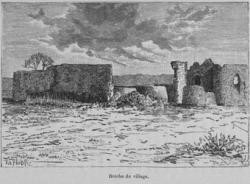Kate Harris
Social Studies teacher
Pittsburgh CAPA
Middle School (13 to 15 years old), High School (16 to 18 years old)
Teacher/Educator
Language Arts And English, Civics, Literature, Cultures, Economics, Social Studies, Geography, Writing, US History, Arts, Other
I'm a history-lover, art fan, and bookworm. I taught high school history (U.S. History and World Religions) for ten years in North Carolina, teach currently in Pittsburgh, PA, and am working to help teachers make the most of this new resource!
Kate Harris's collections
Slave Resistance
This collection includes items representing various forms of slave resistance and rebellion. Students should determine what kind of actions are pictured in the case of each item and use them to create a robust definition of slave resistance.
Guiding Questions:
What does it mean to "resist" slavery?
How did white slave-owners respond to such actions?
Is maintaining a distinct cultural heritage a form of resistance? Why or why not?
How do religion, art, and music encourage resistance?
 Kate Harris
Kate Harris
12
Six Degrees of Separation Example: Lincoln's Axe to William Jennings Bryan
<p>This is a finished version of the "Six Degrees of Separation" AP USH review activity, including annotations explaining the links between objects. This may be useful to share with students the first time you try the activity. Note that connections should be deeper than similarities or coincidental links; they should reflect a causal relationship. In addition, you might ask students to present some analysis of the resources they chose, identifying key details.</p>
<p>The original activity is available here: <a href="https://learninglab.si.edu/collections/six-degrees-of-separation-an-apush-review-activity/C1stNx2FioYNAkWP#r" target="_blank">https://learninglab.si.edu/collections/six-degrees-of-separation-an-apush-review-activity/C1stNx2FioYNAkWP#r</a><br /></p><p><em>#historicalthinking</em></p><p><br /></p>
 Kate Harris
Kate Harris
6
Six Degrees of Separation: An APUSH Review Activity
Use this collection as a starting point for an AP United States History review activity that emphasizes connections and cause-and-effect. Students will copy the collection and add in four resources that form a chain of connection from one item to another (ending with six resources total). For each resource, they should add an annotation describing each of the events or items included, analyzing any important details in the resources themselves, and explaining how each connects to the next one.
 Kate Harris
Kate Harris
2
1950s Conformity and Counterculture
The 1950s were a period of post-war peace and prosperity. The growing economy and baby boom led to a culture of consumerism and growing Cold War tensions led to an embrace of all things American. This student activity includes a number of images reflecting the 1950s (most of them in postage stamp form). After investigating these images and evaluating how they support or challenge conformity, students are asked to research the counterculture that began to develop in the 1950s. The final assessment asks students to create a stamp image reflecting one of the people, events, or movements that pushed back against 1950s conformity. <br /><br />
Guiding questions:<br />
-What caused a sense of American conformity to develop in the 1950s? How was this feeling expressed?<br />
-What challenges to conformity existed in the 1950s?<br />
-Is it more "American" to conform or to rebel?
 Kate Harris
Kate Harris
19
School Integration
<p>The topic of K-12 school integration is a complex one that goes far beyond an understanding of that landmark case, Brown v. Board of Education of Topeka, Kansas. How have efforts at integration been sustained in the 60+ years since that case was first decided? How have concerns about socioeconomic differences been addressed (or not addressed) through school districting? How do district and national policies impact individual students for better or worse? This is a topical collection that addresses the history of school integration but also includes references to and resources reflecting the issue today.</p><p>Tags: segregation, Little Rock Nine, desegregation, charter schools, Arkansas, busing, Boston, racism, prejudice, civil rights</p>
 Kate Harris
Kate Harris
14
Samurai Armor
This collection invites students to consider samurai armor as both functional and expressive objects. The collection includes two informative videos, several examples of samurai armor, photographs, and quiz questions. It finishes with an optional extension activity to make and decorate an origami samurai helmet. This collection can be used independently by students.
Guiding questions to consider are:
1) Why does the material, design, and purpose of an item of clothing matter?
2) How did samurai use their armor to affirm their social status?
3) How did samurai armor evolve over time and reflect changes in Japanese culture?
 Kate Harris
Kate Harris
19
Robber-Baron or Captain of Industry: Andrew Carnegie
<p>This collection includes different perspectives and information about Andrew Carnegie. Students are challenged to build an argument supporting one position or the other: Robber-Baron or Captain of Industry--using the resources as evidence. <strong>Was Carnegie an industrialist who desired to get rich and promote himself regardless of the effects on his workers? Or was he an example of the American dream, an industrial leader who improved the nation and helped its people?</strong></p>
<p>Investigate the items in this collection while thinking about those questions. After an initial review of the collection, complete the sorting activities at the end to test your understanding of the issue and begin to develop an argument reflecting your answer to the question above. </p>
 Kate Harris
Kate Harris
19
Responses to Immigration: Then and Now
<p>This collection will prompt thinking about attitudes towards new immigrants throughout our nation's history. What has changed and what has stayed the same?</p><p>It is also designed to allow users to explore the range of technical features and content resources available in the Smithsonian Learning Lab.</p><p>tags: immigrant, America, assimilate, nativism, stereotypes</p>
 Kate Harris
Kate Harris
10
Remembering the Holocaust
This collection looks at the way artists have used art, literature, and architecture to memorialize the victims of the Holocaust and explores the questions around how an artistic work, memorial, or museum can try to convey an understanding of genocide.
Questions to keep in mind as you observe each work:
1) What is the purpose of this memorial? Is it to honor, remember, educate others, or something else?
2) On what aspect of the Holocaust does this memorial focus?
3) What Jewish symbols are present? What national symbols are present? Are there human figures? Is it abstract? What other features do you notice about this memorial?
4) What is the setting of this memorial? How does that affect its purpose and design?
 Kate Harris
Kate Harris
24
Quilt Quest
<p>Did you know that quilts are also historical artifacts? Use this collection to learn more about how curators investigate quilts to learn about their origins, and then explore a variety of different quilts that tell us important things about the time in which they were made and the crafters who made them. Finally, make your own quilt depicting an important historical moment. </p><p>tags: quilt, craft, activity, review</p>
 Kate Harris
Kate Harris
19
Practice Reading Portraits--Black History Month
<p>This collection was created for a brief warm-up activity where students practiced analyzing portraits of recognizable figures as a group, prior to working on their own portrait analysis. Portraits of Muhammad Ali, Serena Williams, Rosa Parks, and Booker T. Washington are included and they vary in detail and medium. </p><p>The last resource, a PDF file, is a teacher's guide created by the National Portrait Gallery. Teachers should lead discussion about the portraits using suggested questions in the guide, and then let students search for a portrait of someone of their own choosing to analyze.</p><p>tags: civil rights, sports, tennis, boxing, African-American, black history, analysis, comparison</p>
 Kate Harris
Kate Harris
6
Powerful Symbols and Words: Abolitionism & Women's Rights
<p>This collection looks at an image and phrase used widely in abolitionist materials, and at how that symbol was adopted and adapted by Sojourner Truth and/or other women's rights activists. Students will examine an abolitionist medallion and then learn about Sojourner Truth through a short reading, image analysis, and video. They can then review two version's of Sojourner Truth's speech and consider why the second version, as reported by another suffragette, Frances Gage, is markedly different. This collection is designed to be used as a short stand-alone lesson on the topic of the abolition movement and its intersection with the women's movement in the United States.</p><p>Tags: compare and contrast, change over time, "Ain't I a Woman?", abolition, slavery</p>
 Kate Harris
Kate Harris
4






